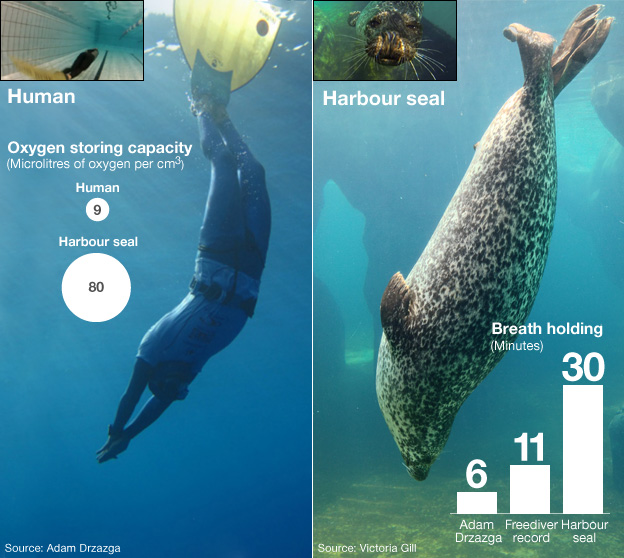Man v seal: How we compare with our marine cousins
- Published
Scientists from the University of Liverpool have published research that explains how marine mammals, including seals and whales, hold their breath for so long.
The research reveals how the oxygen-storing capacity of mammals muscles has been changed by millions of years of evolution.
The videos above show how a highly trained free-diver compares in breath-holding ability to a common seal.
And here we explore some of the most extreme examples of breath-holding in the animal kingdom and how they match up with record-breaking human free-divers.
Common yet extraordinary
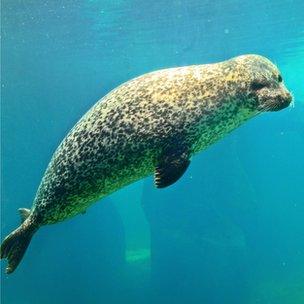
Common seals even sleep underwater for short periods
Common seals, featured in the video above, are widespread and familiar, especially in the waters of the north Atlantic and north Pacific Oceans. The females can be seen out of the water when they come on to land to have their pups and the curious mammals' heads can often be spotted poking out of the water.
But they spend 80% of their time underwater.
These seals can dive for about 30 minutes and even sleep under the water. Their nervous system has an automatic shut-off mechanism that prevents them from breathing at inappropriate times.
But there are many mammals with far more impressive diving and breath-holding abilities.
Squid-eating giant
Along with the beaked whale, the sperm whale is one of nature's best divers. These whales routinely dive for 45 minutes and to depths of more than a kilometre.
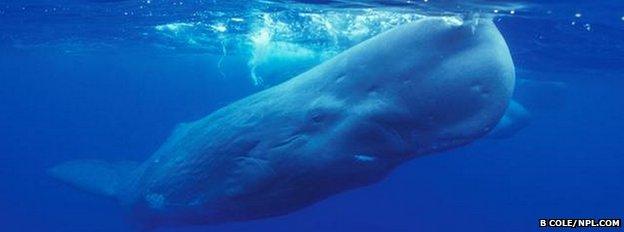
The sperm whale can dive for up to an hour and to depths of a kilometre
This enables them to hunt the giant squid they eat.
Research has shown that they spend almost three-quarters of their time diving and hunting, external.
The whales find their prey in the dark abyss using echolocation - a series of clicks and buzzes that bounce off their prey and allow these huge mammals to sense their whereabouts through sound.
A tracking study using digital tags that was carried out in 2010, external, suggested that the animals worked together - corralling their prey into a "ball of squid".
Elusive beaked beast
With similar digital tags, researchers at the US-based Woods Hole Oceanographic Institution tracked Cuvier's beaked whales diving to nearly 2km and staying down for 85 minutes, external.
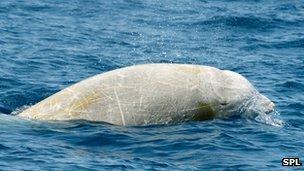
Images of the Cuvier's beaked whale at the surface are rare
This is one of 21 species in the beaked whale group. A recent study by US scientists revealed that beaked whale populations are in decline., external
Because they spend the vast majority of their time below the surface, beaked whales are some of the most mysterious, and this study was the first to give a good estimate of the trend in their population.
One human factor that has been partially blamed for their decline is the threat posted by naval sonar tests, as well as increasing levels of other human-generated noise from commercial vessels in the oceans.
Diving mothers
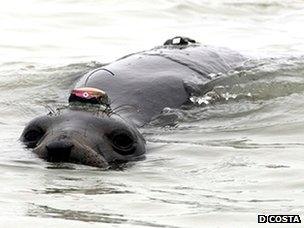
Tracking tags have allowed scientists to measure the deepest dives
Elephant seals, the largest of the seals, spend a good deal more time out of the water than whales, but they are still impressive divers.
A recent tracking study of adult female elephant seals , external- with data from nearly 300 animals - measured one dive to more than 1.7km in depth.
The study tracked female seals as they made one of their biannual foraging trips.
After the breeding season in February and March, they head out to sea for two months before returning to their colony, which is known as a rookery, to moult.
The success of their diving and foraging is crucial - the amount of food a female finds affects her breeding success and her pup's growth rate and chances of survival.
Tiny diver
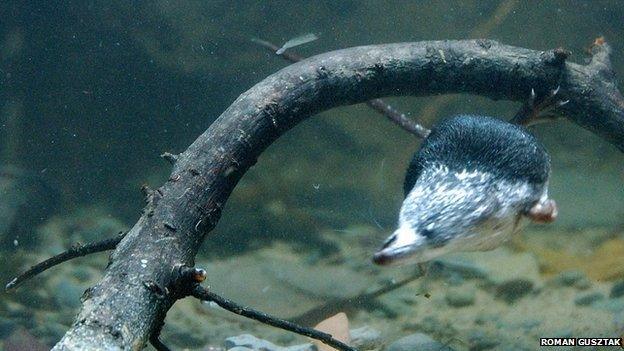
"Silver bullets": Water shrews use speed to reduce the impact of colder waters when diving
It cannot even begin to compete with the giant marine mammals, but the tiny water shrew has some special skills that enable its thumb-sized body to survive the icy water.
The shrew, which is the world's smallest diving mammal, is able to increase its body temperature just before it dives, according to a recent study.
They are even known to "smell" underwater, bubbling air from their nose close to potential prey before sucking it back in.
Human record
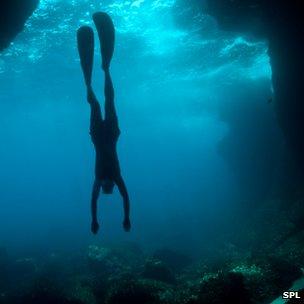
There are eight different disciplines in free-diving
The elite human breath-holders are free-divers. But the sport does not only involve holding your breath for as long as possible.
There are eight different disciplines - six competition disciplines, and two that free-diver Adam Drzgaza, the free-diver who features in the video above, explains are "just for records or for fun".
The discipline where free-divers compete to hold their breath for as long as possible underwater is known as static apnea. A diver remains still and submerged for as long as they are safely able.
Adam says that meditation is a crucial part of free-diving. "If you don't stay relaxed, you can't hold your breath," he tells BBC News.
He is able to hold his breath for an impressive six minutes. But the current world record is held by Stephane Mifsud of France, who managed 11 minutes and 35 seconds in 2009.
Added oxygen
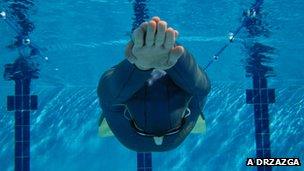
Professional free-divers train to improve their own oxygen storage
In May 2012, a German free-diver named Tom Sietas remained submerged holding his breath for more than 22 minutes.
But the International Association for Freediving, external does not recognise this record, because it involved Sietas breathing pure oxygen to saturate his muscles in preparation for the dive.
"This one was only for a Guinness World Record," Adam explains.
Mr Sietas did hold another free-diving world record for the longest underwater swim , externalon one breath until that was broken by Goran Colak from Croatia who swam 273m during a 2011 competition in Italy.
Deepest man
Herbert Nitsch, an Austrian free-diver is recognised as the "deepest man on earth".
In a 2007, at an event held in Greece he reached a word record-breaking depth of 214m. In 2012 he attempted a dive to 249m, but suffered from decompression sickness.
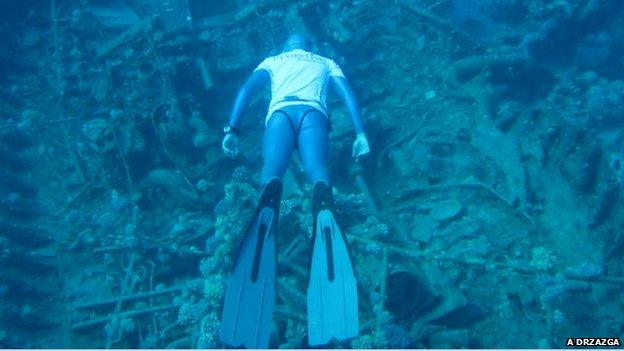
This discipline, where free-divers attempt to reach the greatest depth, is known as no-limits apnea.
This discipline is not competitive, but its records are recognised by the international association for the sport.
Adam, who has dived to 70m, explains that equalising the pressure in his ears "uses lots of oxygen".
"As you dive deeper your chest starts to collapse, making it more difficult to get air from your lungs back to your mouth to equalise," he says.
"You feel your chest getting tighter, your body squished by pressure.
"You can almost say how deep you are, even with your eyes closed."
Walking on the seafloor
The Bajau people of South-East Asia live in stilt houses and fish underwater for up to five minutes on one breath.
Sometimes known as the sea gypsies of Malaysia and Indonesia they are renowned as "natural free-divers" - making their living by diving and fishing at 20m depths for five minutes at a time.
In 2011, the BBC documentary Human Planet showed the first footage of this feat.
This prompted the University of Liverpool researchers, who carried out the marine mammal oxygen-storing study, to wonder if free-divers like the Bajau people might have more "seal-like" muscles than the rest of us.
Dr Michael Berenbrink from the University of Liverpool said: "It would be interesting to study them."
- Published14 June 2013
- Published13 June 2013
- Published13 June 2013
- Published12 January 2011
